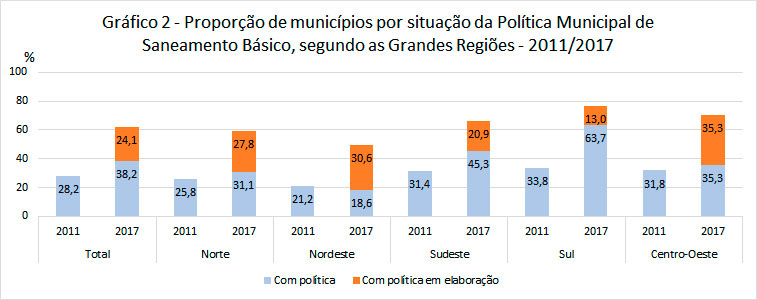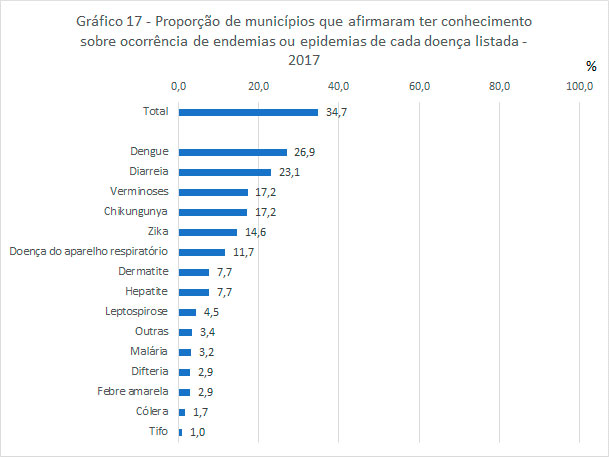Munic: more than half of Brazilian municipalities did not have any basic sanitation plan in 2017
September 19, 2018 10h00 AM | Last Updated: September 24, 2018 11h20 AM
In 2017, 41.5% of the 5,570 Brazilian municipalities reported to have a Municipal Plan of Basic Sanitation with diagnoses, objectives and universalization goals, among other contents.
Concerning the Municipal Policy of Basic Sanitation – which outlines general guidelines for the services –, 38.2% of the Brazilian municipalities reported to have it and 24.1% reported to be developing it. In 2011, the percentage of municipalities with a Municipal Policy of Basic Sanitation was 28.2%.
In 2017, only 17.2% of the municipalities (958) reported to have Municipal Councils of Sanitation, being 816 exclusive in this area and 142 together with other policies. They were 195 municipalities in 2011. This information comes from the supplement of Basic Sanitation of Munic 2017. The complete publication and the support material of the survey are on the right side of this page.
41.5% of municipalities have Municipal Plans of Basic Sanitation
In 2017, 2,313 Brazilian municipalities (41.5% of the total) had Municipal Plans of Basic Sanitation - PMSB (either regulated or not). This percentage was 10.9% in 2011. The South Region registered the most significant increase between 2011 (13.5%) and 2017 (72.9%).
The proportion of municipalities whose plan was regulated by a legal instrument also increased between 2011 and 2017 (from 77.8% to 90.1%), a value similar in all the regions. On the other hand, the proportion of municipalities with plans (either regulated or not) was quite unequal in regional terms, varying from 15.7% in the Northeast to 72.9% in the South.
In 2017, the Federation Units with the highest proportion of municipalities with plans were Santa Catarina (87.1%) and Rio Grande do Sul (75.5%), whereas the lowest ones were reported in Paraíba (13.0%), Pernambuco (14.1%) and Bahia (14.6%). Of the 139 municipalities of Tocantins, five reported to have a plan in 2011 and 62, in 2017.
Concerning the classes of population size of the municipalities, the existence of a PMSB tended to be more frequent in those within the highest classes. The proportion of municipalities with a PMSB (either regulated or not) only surpassed 60.0% in those with more than 100,000 inhabitants. The highest growth rate, on its turn, was among the smallest municipalities, whose number rose more than six times between 2011 (6.8%) and 2017 (46.8%).

In 2017, 38.2% of municipalities have policies of basic sanitation
In Brazil, 2,126 municipalities (38.2%) reported to have Municipal Policies of Basic Sanitation in 2017, an increase of 35.4% over 2011 (28.2%). A total of 1,342 municipalities (24.1%) were developing their policies in 2017, an information that did not exist in 2011.

While 63.7% of the municipalities in the South reported to have such policy in 2017, they were 18.6% in the Northeast. Between 2011 and 2017, the biggest advances were reported in the South (89.3%) and Southeast (44.4%).
Among the 42 municipalities with more than 500 thousand inhabitants in 2017, 29 (69.0%) reported to have Municipal Policies of Basic Sanitation. They were 22 municipalities in 2011. Other six reported to be developing their policies. Nevertheless, the highest growth rates were reported in the municipalities with up to 5,000 inhabitants (increase of 72.2% – from 277 to 477 municipalities) and in those between 5,000 and 10,000 inhabitants (61.7% – from 269 to 435).
The creation of the legal instrument was before 2007 in only 93 municipalities, year of Law no. 11,445. Since then, other 1,636 municipalities developed their policies by means of legal instruments, highlighted by the years of 2013 (268) and 2015 (291).
Most of the municipalities with Municipal Policies of Basic Sanitation (87.7%) included Municipal Plans of Basic Sanitation - PMSB within it. Then, the form of provision (directly or by proxy) and regulation (appointment of the entity in charge of regulating and auditing) of the services are the most common (45.4% and 45.1%, respectively).
Endemic or epidemic of diseases linked with basic sanitation hit 34.7% of municipalities
In 2017, 34.7% of the municipalities reported to know of the occurrence of endemic or epidemic of diseases linked with basic sanitation. Dengue was the most mentioned disease among the municipalities (26.9%).
The proportion of municipalities that reported to have suffered from epidemic or endemic of dengue, zika and chikungunya in the last 12 months before the interview date was higher in the Northeast and North Regions, highlighted by the Northeast Region, where 29.6% of the municipalities reported to have passed through epidemic or endemic of zika and 37.3%, of chikungunya. Conversely, yellow fever was more mentioned in the municipalities of the Southeast (5.1%) and North (4.7%).

17.2% of municipalities have Municipal Councils of Sanitation
Despite the legal ordinance, only 958 (17.2%) of the 5,570 Brazilian municipalities reported to have Municipal Councils of Sanitation in 2017, being 816 exclusive in this area and 142 together with other policies. Even so, this was a higher figure than that reported in 2011 (195 municipalities).
The South Region (33.9%) was the region with the highest proportion of such councils, followed by the Central-West (20.1%). In the North and Northeast, only 8.4% of the municipalities had such collegiate body. Santa Catarina was the state with the highest proportion of municipalities with such councils (58.3%). The states of Amazonas and Amapá were on the opposite side, without any municipality with such council.
In general terms, the proportion of municipalities with councils was higher for the most populated municipalities. In 2017, 40.5% of the municipalities with more than 500,000 inhabitants had such structure of control and social participation, whereas 16.6% of those with up to 5,000 inhabitants and 13.8% of those between 5,000 and 20,000 inhabitants reported too have such council.
Up to 1990, only five municipalities had such type of collegiate body: Galileia (MG), João Monlevade (MG), Ouro Preto (MG), Santa Isabel (SP) and Sorriso (MT). Most of the councils (818 or 89.0%) were created after 2007, year of Federal Law no. 11,445, that deals with basic sanitation services in Brazil. 2015 was the year in which most councils were created (221).
10.4% of municipalities have Municipal Funds of Basic Sanitation
In 2017, 580 municipalities reported to have Municipal Funds of Basic Sanitation (10.4%) in Brazil, whereas they were 215 (3.9%) in 2011.
Among the Major Regions, the highest proportion of municipalities with such fund was the South Region, both in 2017 (21.6%) and in 2011 (7.3%). On the other side, only 5.9% of the municipalities in the Northeast reported to have Municipal Funds of Basic Sanitation in 2017. Nevertheless, the Northeast was the region in which the number of municipalities that reported to have such fund mostly increased, changing from 34 (2011) to 105 (2017).
Santa Catarina (42.7%) and Rio Grande do Sul (18.1%) were the Federation Units that mostly stood out. The highest growth in the number of municipalities that reported to have such funds was registered in Paraná, changing from three (2011) to 41 (2017).
Concerning the classes of population size, the proportion of municipalities with such funds was higher among the municipalities with higher size classes. The proportion was 31.0% among those with more than 500 thousand inhabitants, while it was 9.8% among those with up to 5 thousand inhabitants. Nonetheless, the highest growth was recorded among the latter, changing from 31 (2011) to 121 (2017).
South and Northeast are regions with highest proportion of municipalities participating in joint ventures in basic sanitation
In 2017, 30.2% of the 5,570 municipalities reported to participate in joint ventures in the area of basic sanitation. The South (34.9%) and Northeast (31.6%) were the regions where they were mostly common. The proportion of municipalities was the lowest one in the North (17.8%). Concerning the Federation Units, the highest proportion was recorded in Sergipe (78.7%) and Rondônia (75.0%).
The joint ventures worked more in management of solid waste and 1,257 municipalities reported to participate in joint ventures in this area. On the other hand, only 255 municipalities participated in joint ventures in the area of management of rainwater.
In 2017, 16.3% of municipalities have Municipal Information Systems and 31.4%, municipal ombudsmen or call centers
In Brazil, only 16.3% of the municipalities reported to have public Municipal Information Systems and 31.4% reported to have either municipal ombudsmen or call centers. The Southeast was the region with the highest proportion of municipalities with public Municipal Information Systems (21.7%) and, beside the Central-West, it was also with the highest proportion of municipalities with municipal ombudsmen or call centers (38.1% and 38.3%, respectively).
The proportion of municipalities with public municipal information systems on sanitation did not surpass 30.0% in none Federation Unit. Regarding the existence of municipal ombudsmen or call centers, Ceará and Mato Grosso were the only ones in which more than 60.0% of the municipalities responded positively.
Concerning the classes of population size, both channels were more present in the mostly populated municipalities. In those with up to 5 thousand inhabitants, only 11.0% had public information systems on basic sanitation and 18.9% had municipal ombudsmen or call centers. These proportions were 40.5% and 85.7%, respectively, in the municipalities with more than 500 thousand inhabitants.

